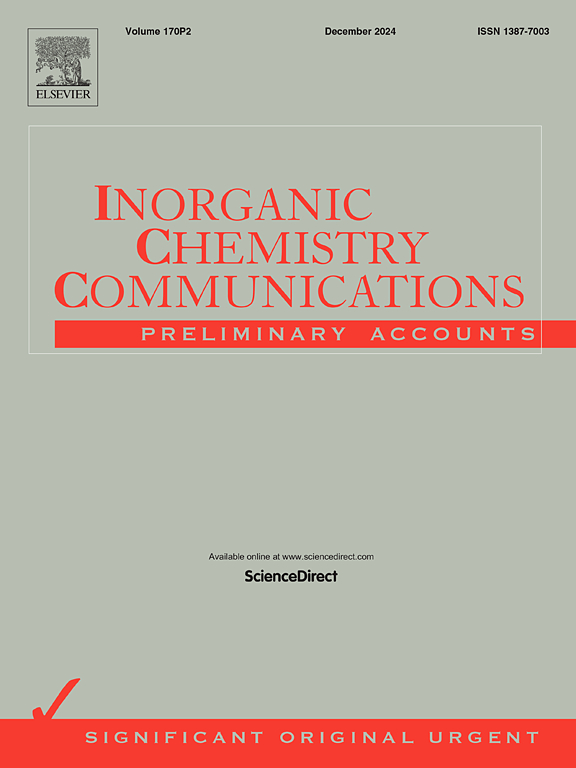具有增强抗菌和光催化性能的丝胶稳定氧化锌纳米颗粒的晶体学分析
IF 4.4
3区 化学
Q1 CHEMISTRY, INORGANIC & NUCLEAR
引用次数: 0
摘要
生物稳定剂在纳米颗粒合成中的应用由于其环境友好和可持续的特点而引起了人们的广泛关注。本研究利用丝胶蛋白作为生物稳定剂合成氧化锌纳米颗粒(ZnO NPs)。采用x射线衍射(XRD)、紫外可见光谱(UV-Vis)、傅里叶变换红外光谱(FTIR)、扫描电子显微镜(SEM)和能量色散x射线能谱(EDS)对丝胶稳定氧化锌纳米粒子(SS-ZnO NPs)进行了分析。XRD证实其为六方纤锌矿结构,平均晶粒尺寸为11.02 nm。紫外可见光谱显示在380.0 nm处有明显的吸收峰,光学带隙为3.23 eV,而在448.0 cm−1处的FTIR峰对应于Zn-O拉伸,表明ZnO NPs的存在。EDS分析表明,锌和氧的质量分数分别为85.08%和14.92%。扫描电镜显示为均匀的球形形貌,平均直径为32.48 nm。用亚甲基蓝染料评价了SS-ZnO NPs的光催化活性,与未封顶的ZnO相比,SS-ZnO NPs表现出更好的降解能力。此外,纳米颗粒对耐药革兰氏阳性金黄色葡萄球菌和革兰氏阴性大肠杆菌表现出较强的抗菌活性。研究结果证实,丝胶稳定的ZnO NPs具有优异的光催化和抗菌性能,使其成为环境修复和抗菌应用的有希望的候选者,特别是在对抗水污染和耐药病原体方面。本文章由计算机程序翻译,如有差异,请以英文原文为准。

Crystallographic analysis of silk sericin-stabilized zinc oxide nanoparticles with enhanced antimicrobial and photocatalytic properties
The use of bio-stabilizers in nanoparticle synthesis has attracted considerable interest because of their environmentally friendly and sustainable characteristics. In this study, silk sericin was utilized as a bio-stabilizer for synthesizing zinc oxide nanoparticles (ZnO NPs). The silk sericin-stabilized zinc oxide nanoparticles (SS-ZnO NPs) were analyzed using X-ray Diffraction (XRD), UV–Vis spectroscopy, Fourier Transform Infrared Spectroscopy (FTIR), Scanning Electron Microscopy (SEM), and Energy-Dispersive X-ray Spectroscopy (EDS). XRD confirmed a hexagonal wurtzite structure with an average crystallite size of 11.02 nm. UV–Vis spectroscopy showed a distinct absorption peak at 380.0 nm and an optical band gap of 3.23 eV, while the FTIR peak at 448.0 cm−1 corresponds to Zn–O stretching, indicating the presence of ZnO NPs. EDS analysis confirmed the mass percentages of Zn and O as 85.08 % and 14.92 %, respectively. SEM revealed a uniform spherical morphology with an average diameter of 32.48 nm. The photocatalytic activity of SS-ZnO NPs was evaluated using methylene blue dye, demonstrating superior degradation compared to uncapped ZnO. Additionally, the nanoparticles exhibited strong antibacterial activity against drug-resistant gram-positive Staphylococcus aureus and gram-negative Escherichia coli. The findings confirm that silk sericin-stabilized ZnO NPs possess excellent photocatalytic and antibacterial properties, making them promising candidates for environmental remediation and antibacterial applications, particularly in combating water pollution and drug-resistant pathogens.
求助全文
通过发布文献求助,成功后即可免费获取论文全文。
去求助
来源期刊

Inorganic Chemistry Communications
化学-无机化学与核化学
CiteScore
5.50
自引率
7.90%
发文量
1013
审稿时长
53 days
期刊介绍:
Launched in January 1998, Inorganic Chemistry Communications is an international journal dedicated to the rapid publication of short communications in the major areas of inorganic, organometallic and supramolecular chemistry. Topics include synthetic and reaction chemistry, kinetics and mechanisms of reactions, bioinorganic chemistry, photochemistry and the use of metal and organometallic compounds in stoichiometric and catalytic synthesis or organic compounds.
 求助内容:
求助内容: 应助结果提醒方式:
应助结果提醒方式:


